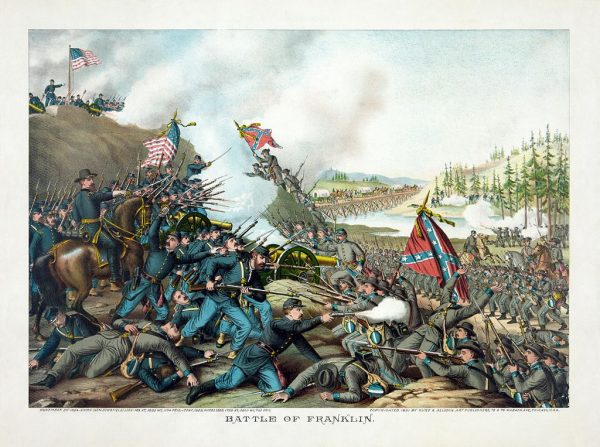Monuments don’t just appear in the wake of someone’s death — they are erected for reasons specific to a time and place. In 1905, one such memorial was put up in downtown Memphis, Tennessee, to commemorate Nathan Bedford Forrest, who had died in 1877.

Forrest was a lieutenant general in the Confederate Army during the American Civil War, and widely regarded as a military genius. Ulysses S. Grant called him “that devil Forrest.” Robert E. Lee lamented not putting his talents to greater use during the war.
Forrest was wealthy, but he built his fortune with the labor of enslaved persons. He was also a member (and, according to some accounts: the first Grand Wizard) of the Ku Klux Klan.
When the statue of Bedford Forrest was erected in Memphis in 1905, explains Memory Palace host Nate Dimeo,
“They held a parade at the unveiling of the new statue and made speeches to honor the northward facing general. They said nothing of slavery. They said much about heritage and honor and chivalry. They said nothing … of the terror it had wrought, nothing of the assassinations or the lynchings.”

This featured episode explores the idea of an imagined plaque that could accompany a statue of Nathan Bedford Forrest. Nate DiMeo originally produced this story for his show The Memory Palace under the title: Notes on an Imagined Plaque to be Added to the Statue of General Nathan Bedford Forrest, Upon Hearing that the Memphis City Council has Voted to Move it and the Exhumed Remains of General Forrest and his Wife, Mary Ann Montgomery Forrest, from their Current Location in a Park Downtown, to the Nearby Elmwood Cemetery.




Comments (5)
Share
One of, if not *the*, best episodes of The Memory Palace. I listened to it while I was walking, so I couldn’t have had a “driveway moment,” but I probably slowed down and inhaled deeply for those last minutes.
DiMeo’s delivery is . . . I was going to write a slow burn, but he never really grows angry; but you can sense the fury as he closes in on the rhetorical quarry.
It was timely when it was released, and is more timely now. I’ve been posting links on discussion groups and tweeting it out. Thanks for “bumping” it again.
I remember hearing this on The Memory Palace, but it’s a good reminder.
I’ve always read the plaques (my parents did it when we were kids and it stayed with me), but now I hear Roman’s voice in my head when I see one and feel a connection with all of the others reading the plaques.
I’ve recently been visiting state parks and memorials here in Minnesota. The number of monuments dedicated to the immigrants and military/government representatives in the “Dakota War” are in the hundreds. Very few discuss why the violence occurred, how the government and military treated the Native Americans (not only in the Dakota War of 1862, but during other times), and how the Sioux Nation was betrayed by those they trusted. There are other stories in these monuments that have often been constructed by the victors of the battles or by the descendants of the immigrants in the battles that are not told. These stories, rarely told, much like those mentioned in this piece, are often an addendum, in one line, in smaller type at the bottom, after the recount of the heroism of the white people in an entire plaque above it.
We do an injustice to history and ourselves to not realize the entire scope of an event or a time period.
I listened to the podcast and I agree that we don’t memorialize these kinds of people anymore- times have changed and as a society we have evolved. I just feel like allocating resources to take down every statue in America of this nature is a waste- aren’t we better off using this money for education? To better the present?
A statue is an object, a nondescript visual. If you take down the plaque saying who it is, what is it then? Just some random historical figure on a horse or standing there. No one recognizes who it is bc that person is long dead.
I understand the point but unless the community wants to remove it with their own resources, why waste another dime that could be better spent helping people, educating them and making a real difference?
Europe doesn’t take down statues of long dead leaders who massacred and enslaved thousands for the sake of their country. They keep them, and even though people know what they did was wrong they know it was history- we are in a different time now. (Not counting the Lenin statues in the Ukraine which were propaganda)
This episode gave me goosebumps. The emotional freight is so raw and relevant. I loved how precisely he captured the purpose of coded language like “heritage” and “honor” that has always been prevalent in the South.
It takes a lot of linguistic and cultural contortion to maintain the cognitive dissonance of considering oneself a “decent” human being while being passionate about defending the “right” to own and sell human beings, segregation, and legal dehumanization rituals.
This episode helped me understand why Southern people of all varieties are able to decipher racist dogwhistling, but people in the North are more likely to accept superficial interpretations of rhetoric. My family is from North Carolina, and for a while it amazed me that people from where I am now (SF) couldn’t detect the racially incendiary components of current political discourse. I see that this has been going on for over 100 years. I was floored by this episode, thanks Roman for amplifying it.
-Memorials aren’t memories, they have motives- thanks for the goosebumps, really one of the best episodes